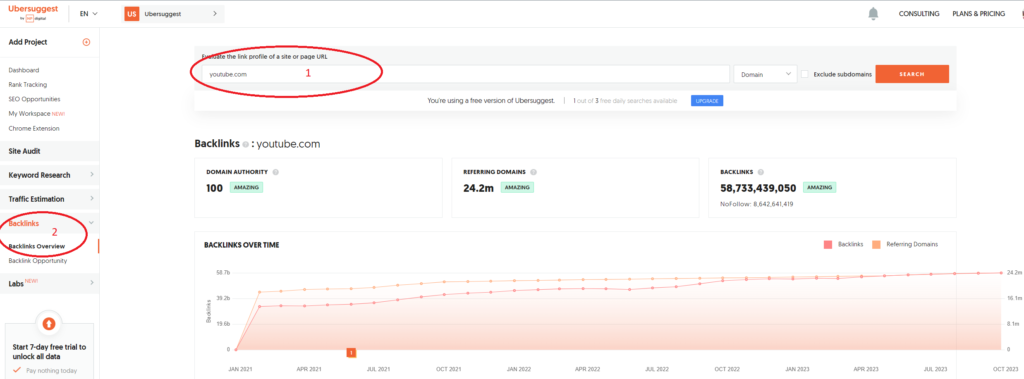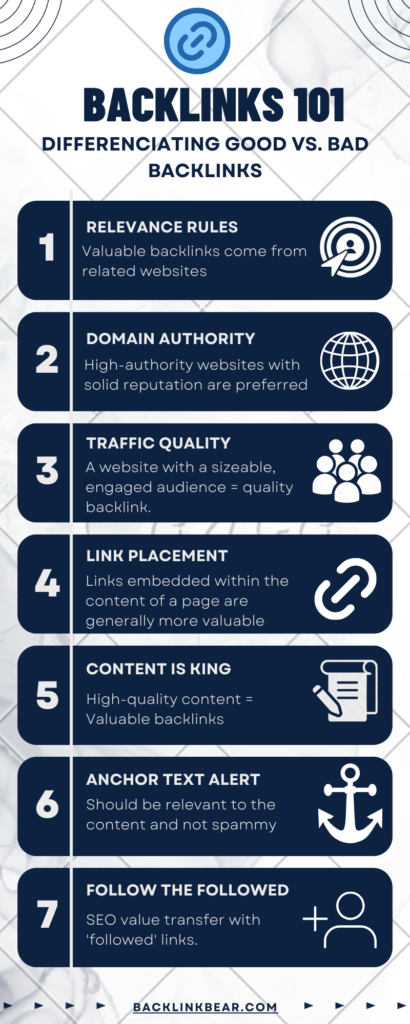So you’ve heard all this buzz about backlinks and how they can skyrocket your website’s SEO rankings. But here’s the thing: how do you even know if a website has backlinks? It’s like trying to find Bigfoot, am I right?
So today, we’ll dive deep into the world of backlink detection. We’ll discuss some nifty tools and techniques to help you uncover those elusive backlinks and gain valuable insights into your or your competitor’s website’s link profile.
Steps to Find Backlinks of a Website:
If you want to know whether or not a website is being linked by other websites and the authority of most websites linking to it, then you can see up to websites linking back to that specific website for free.
After that, you will have to pay to get a complete list as almost every tool is freemium, meaning a small part is free, and the rest of it is premium. That said, here are two tools I like to use the most:
Using Ubersuggest:
- Go to Ubersuggest and enter the website URL you want to check, for example, Youtube.com
- Click “Backlinks” on the left sidebar and then “Backlink Overview”. Scroll down, and you will see a list of all the backlinks to that website.
- Click on any backlink for details like Domain Authority, Spam Score, and Link Type.
- However, this list will be limited to 100 links; you must subscribe to Ubersuggest to see all website backlinks.

Using Semrush:
- Go to SEMRUSH and enter the website URL (example: Youtube.com) to analyze.
- Click on “Backlinks” on the left sidebar and then on “Backlink.” Scroll down, and you will see a list of all the backlinks to that website.
- Sort backlinks by Authority Score – links from high DR sites are good.
- Check Link Type and Anchor – Branded and Image links are better than Text links.
- Identify relevant, high DR sites linking with good anchor text.

Other Tools Suggestions:
Identifying Good vs. Bad Backlinks
In the vast universe of SEO, understanding the difference between good and bad backlinks is crucial. But don’t fret; we’re here to guide you through everything with a friendly smile and detailed explanations.
Relevance of Backlinks
One of the primary factors to consider when identifying good backlinks is relevance. Generally, backlinks from websites within the same industry or related fields are deemed valuable. Like if you have a fitness blog, a backlink from a health and wellness site could boost your site’s SEO. On the other hand, a link from an unrelated website, say a car dealership, may be seen as a low-quality link by search engines.
Domain Authority
High-authority websites with a solid reputation are the golden geese of backlinks. These sites are considered trustworthy, so a backlink from them can significantly enhance your website’s SEO. A study from Moz showed that areas with a high domain authority tend to rank higher on search engine results pages (SERPs). It’s like getting a stamp of approval from the big leagues!
Traffic Quality
Digging a little deeper into the website providing the backlink, it’s essential to assess its traffic quality. A website with a sizeable, engaged audience is a good indicator of a quality backlink. Think of it as a busy store in a shopping mall – if there’s a crowd, it’s worth checking out.
Link Placement
The location of backlink insertion on a webpage can also influence its value. Links put within the content of a page are generally more valuable than those tucked away in footers or sidebars. It’s akin to a billboard in a prime location – more visibility means more value!

Quality Content
The quality of content where your backlink is placed matters significantly. High-quality, original content is a green flag, while low-quality or duplicated content could signal a red flag to search engines. For instance, a backlink on a well-researched article carries more weight than on a page filled with generic, copy-pasted information.
Non-Spammy Anchor Text
The anchor text or the clickable text in a hyperlink needs to be relevant to the content and not overloaded with keywords. Spammy anchor texts can lead to penalties from search engines. For example, if your backlink is anchored to the text “best fitness tips” but directs to a page selling protein powder, it may be seen as spammy.
Followed Links
Finally, ‘followed’ backlinks are more desirable than ‘nofollow’ backlinks. These links transfer SEO value from the linking website to yours, like a baton in a relay race. Conversely, ‘nofollow’ backlinks, while they might bring in traffic, do not pass on this SEO value.
Remember that quality trumps quantity. A few good backlinks can outperform numerous bad ones. So, keep these factors in mind when assessing your website’s backlink profile. Happy optimizing!
Obtaining the Same Backlinks as Competitors
If you are trying to find the backlinks of your competitors and then replicate the same backlink profile as them for your own website, then here’s how to do precisely that:
Create a List of Target Websites
Creating a list of target websites is the initial step toward obtaining the same backlinks as your competitors. You want to focus on the sites already linking to your rivals. To find these, you can use tools such as Ahrefs or SEMRush. These tools will reveal the backlinks of any website, including your competitors. Once you have a list, prioritize the higher quality and authoritative websites. For example, getting a backlink from The New York Times would have a more significant impact on your SEO than a lesser-known blog.
Evaluate Linking Opportunities
Now that you have your list visit each website and evaluate whether they are relevant to your content, products, or services. Check if your content can add value to their audience. For instance, if you run a fitness blog and a target website is a health portal, you can offer a guest post on exercise routines. Relevance is critical because Google gives more weight to backlinks from relevant sites.
Building Relationships
Building relationships is an essential part of the backlink-building process. Engaging with website owners, editors, or social media managers can help create a sense of trust and credibility. You can engage with them on social media or comment on their articles, offering valuable insights. Remember, the aim is to build a strong relationship rather than getting a backlink immediately.
Guest Blogging and Contributions
Guest blogging is one of the best ways to earn backlinks. Start by creating high-quality, engaging content relevant to your target websites. Ensure that your content is on par or better than your competitor’s offer. Once ready, send a personalized email to the website owner. Explain how your content will provide value to their audience. Avoid generic pitches; tailor your message to each recipient.
Diversify Anchor Text and Content
To make your backlinks appear natural, diversify your anchor text. For instance, if you’re trying to rank for ‘best-running shoes,’ use variations like ‘top-rated running shoes’ or ‘high-quality running shoes.’ Over-optimized anchor text can be a red flag for search engines, potentially leading to penalties.
Monitor and Follow Up
Always keep track of your outreach efforts and responses. If you are still waiting for a reply from a website owner, send a follow-up email after a week or two. Once a backlink is secured, monitor it regularly to ensure it remains active and doesn’t turn into a broken link. Regular monitoring can prevent any potential damage to your SEO.
Keep Maintaining Your SEO Efforts – It’s Never an Overnight Success:
Remember, SEO and backlink building is a marathon, not a sprint. Continuously seek new opportunities and nurture relationships with existing websites.
Keep an eye on your competitors and tweak your strategy as needed. Remember, what worked yesterday may not work tomorrow in the ever-changing world of SEO!